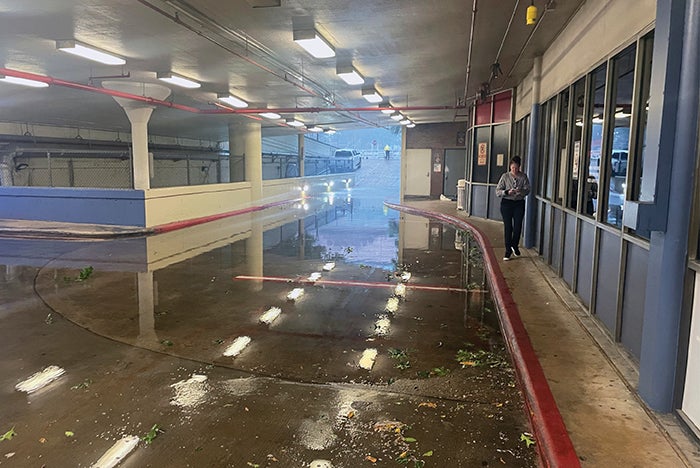After Beryl, Houston hospitals faced post-hurricane patient surge

Floodgates at Baylor St. Luke’s Medical Center were closed to prevent flooding due to Hurricane Beryl.
Image courtesy of St. Luke’s Health
In July 2024, Hurricane Beryl broke records as the earliest Category 5 hurricane to form in the Atlantic Ocean. Yet by the time the storm passed directly over Houston as a Category 1 on July 8, area hospitals were largely prepared to navigate the challenges associated with 80-mph winds and rain. For many of these hospitals, it was the surge of patients that came after the storm that posed the greatest challenge.
Between 2 million and 3 million people lost power at the peak of the storm. Some people in the Houston region remained without electricity for up to two weeks later. As Texas temperatures surged in the days after Beryl, emergency rooms saw spikes in heat-related illnesses from vulnerable populations left without air-conditioning.
“The vast majority of hospitals in southeast Texas dealt with some form of post-Beryl challenge, whether that was water damage, power issues, connectivity issues, staffing shortages, wind damage or transportation challenges with debris in the area,” says Carrie Williams, chief communications officer for the Texas Hospital Association. “Our biggest concern was for the subset of those hospitals that are running on emergency generators or have no connectivity. There were roughly 20% of hospitals in the southeast Texas area using emergency generators for power, and others were having connectivity issues.”
This included facilities like St. Luke’s Health–Patients Medical Center in Pasadena, Texas, which switched onto generator power during the hurricane. Brad Lembcke, M.D., MBA, president of Baylor St. Luke’s Medical Center in Houston, explains, “We ended up having to evacuate that hospital because the temperatures rose too high over the course of the next day-and-a-half.”
According to local news outlets, Houston’s Office of Emergency Management reported that 29 hospitals across the region were impacted by Hurricane Beryl. However, with restoration of services prioritized for hospitals, lingering impact was largely felt at outpatient facilities and clinics. As hospitals returned online, they found a significant influx of patients. Harris Health Ben Taub Hospital in Houston reported a 34% increase over its typical volume highs. Across its facilities, St. Luke’s faced higher rates of admission among vulnerable patients, including seniors transferred to the hospital after their nursing home lost power.
“We had about 45 patients whose discharges had to be delayed until other arrangements could be made or they got power back,” Lembcke says. “It’s difficult to send a 90-year-old to a 90-degree house.” He adds that surge plans implemented during the COVID-19 pandemic enabled the health system to quickly adapt to conditions.
Kristen Kupperman, vice president of design, construction and facilities for Texas Medical Center, notes that NRG Arena, home of the NFL’s Houston Texans, was turned into a transition facility capable of housing up to 250 patients. Space was prioritized for discharged individuals unable to return home due to outages or damage.
Services that support health care campuses also sustained damage and impacted staffs’ ability to get to work. Houston’s public transit bus service was disrupted for more than a week, and gas stations faced long lines and shortages. Some systems, like St. Luke’s, provided free gasoline for staff via tankers brought on-site.
Overall, the speedy recovery seen by the region’s acute care facilities was the result of strong communication in advance of the storm. Lembcke notes that, prior to Beryl’s arrival, St. Luke’s staff was invited to stay the night at its health care facilities. “About 100 members of our staff came in,” he says. “Others, who were working that Sunday night stayed late and continued to take care of patients or slept here during the day.”
Kupperman adds, “When we know that we’re in the pathway of a hurricane — even if it’s 30 to 60 miles in either direction of us — we start to prep our team. Since it was a direct hit to Houston, about two to three days before the storm we started to prepare our ride-up teams. We did have a team on-site throughout the entire storm, and we had a couple of additional personnel come in for cleanup after the hurricane passed.”
Now, health systems are looking at strategies to enhance planning for future weather events. “We’re taking a look at all of those things that may have not been replaced in the last 10 years, especially in our garages and across our sidewalks, to make sure that everything is storm-ready,” Kupperman says. “We’re also starting to work more closely with arborists to ensure our trees can withstand these weather events.”




